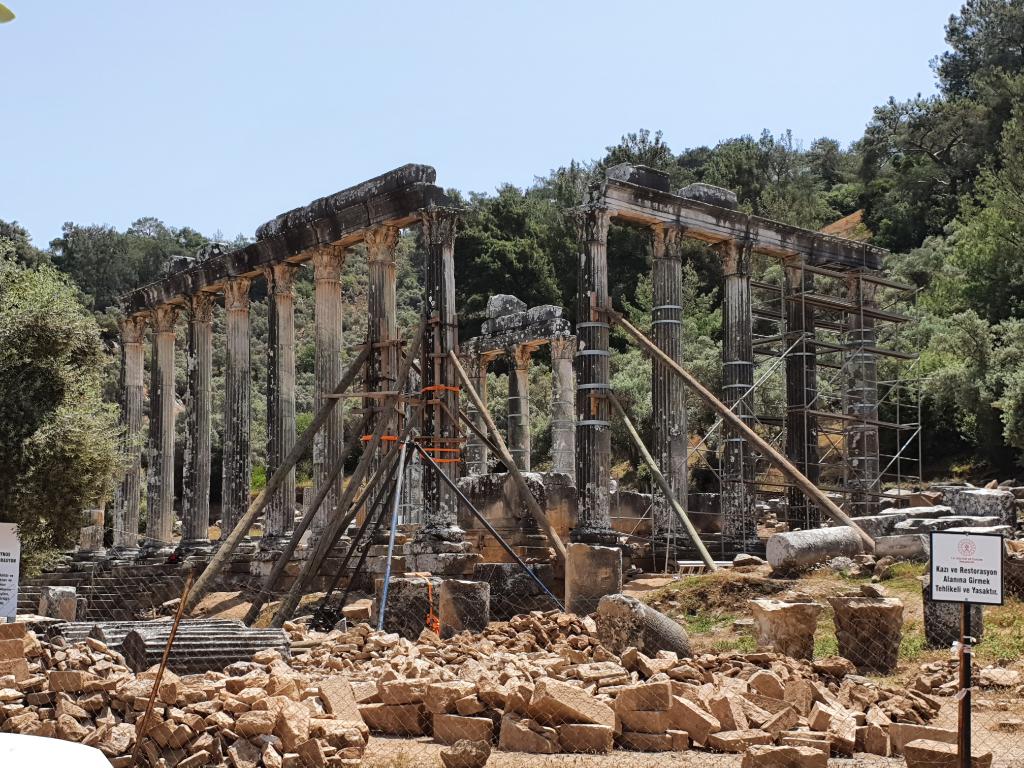By Glenn Maffia
FOR several months I have been reading about the ongoing restoration of the Temple of Zeus Lepsynos located within the antique city of Euromos, about halfway between Didim and Bodrum. It hasn’t made for pleasurable reading from my point of view, I can assure you.
Historical point
Though the city probably dates back to the Archaic Period (6th century BCE), the temple we see today became active during the reign of Hadrian between 117-138 CE. It conceivably replaced an archaic timber-made temple dedicated to the same god.
Carian rock tombs found in the foothills above the city alluringly suggest evidence of an older settlement dating before the Greek occupation of these Aegean lands. The Carians were, along with many other groups within Turkey, indigenous to all intents and purposes.
Reservations on renovations
Euromos’ excavation director, Prof. Abuzer Kizil, told the press his team intended to ‘rebuild’ the fallen columns from the Temple. Many of the original column drums had been located after successive excavations.

Kizil explains: “We use chrome rods to join the large architectural blocks (column drums). After we put the columns together, we will put them back in their original places.” He strongly attests “his team has complied with international restoration rules without using modern materials.”
I am extremely reticent of so-called restorations or renovations when describing the alterations of an ancient site. I do not believe we could conceivably do it to any degree of ‘authentic’ competence. And such a need has diminished with the advent of 3-D computer graphics.
Maintenance and preservation I endorse wholeheartedly and with conviction. I have observed the German archaeologists over many years at Didyma, a place I have called home for almost two decades. Maintenance has been a predominant feature every single year they have been here.
More importantly, they have undertaken some of the most essential relevant and revealing archaeological work. And not even attempting a pastiche restoration which appears to preoccupy local archaeologists.
An aesthete’s concern
Now, this brings me to a crucial point, which appears to be abjectly and woefully neglected by the assembled ministries embroiled in the rather confusingly conjoined areas of Culture and Tourism – the best definition of an oxymoron as I have ever heard.

One of the modules I studied at university was the discipline of Aesthetics, which is broadly the philosophy of art. This is about the nature of art and the concerns in which individual works of art are interpreted and evaluated.
The alteration of any original art work cannot be conceived of as adding to its intended allure. Indeed, it necessarily deflects from the essence of the work. It is akin to replacing the lost arms of the Venus de Milo, an action that would be viewed as nothing short of vandalism.
For the love of tourism, over history
Let us not have any delusion here; this is a touristic project, not an archaeological endeavour. This restoration, and many others I have noted, teaches us nothing new, apart from the country is in desperate need of tourist revenues. That deeply offends my sensibilities that history could be manipulated in such a callous manner.
Restorations, to me, are anathema which merely creates discord and dissonance. A foreboding which was amplified when visiting recently, I observed the pristine white, machine cut, rectangular marble blocks aligned in neat rows awaiting positioning, and some already implanted to ‘restore’ the naos/adyton (inner-sanctum). I thought, “This is not archaeology. This is merely an extension of mass tourism”. As I let out a resigned sigh, my heart plummeted.

I cannot help but think the indisputable ‘cash cow’ success of, for example, Ephesus has irreversibly coloured the perspectives of archaeologists, or rather their masters, as to what their function should be.
It must be the case that their function should be to preserve history, record it and reveal history in educational terms.
As I alluded to above, there is a scant reward in restoring ancient structures with the advent of 3-D computer graphics with its infinite versatility. The obvious advantage would be the medium’s ability to adapt to the newly acquired information.
I have witnessed many restorations from 50 years ago, which appear laughable today. I do not place any blame upon the archaeologists responsible for they were only working with the information then available. The point is that it is a far simpler task and less expensive to reprogram a computer than to tear down a mistaken ‘folly’ and restore it with the parameters of any new information that may arrive.
Granted, this may infuriate the tourists who desire their ‘happy snaps’, but what should take precedence? As far as I am concerned, there is no question.
I cannot conceive of this Temple of Zeus Lepsynos restoration, or many similar projects, being culturally relevant. Do we have the moral authority to shape our collective past into a commercial touristic entity?
